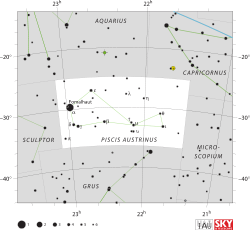Lambda Piscis Austrini
 | |
| Observation data Epoch J2000.0 Equinox J2000.0 (ICRS) | |
|---|---|
| Constellation | Piscis Austrinus |
| Right ascension | 22h 14m 18.75180s[1] |
| Declination | −27° 46′ 00.8667″[1] |
| Apparent magnitude (V) | +5.42[2] |
| Characteristics | |
| Spectral type | B7 V[3] |
| B−V color index | −0.12[2] |
| Astrometry | |
| Radial velocity (Rv) | −6.20[4] km/s |
| Proper motion (μ) | RA: +23.60[1] mas/yr Dec.: −6.20[1] mas/yr |
| Parallax (π) | 6.51 ± 0.33[1] mas |
| Distance | 500 ± 30 ly (154 ± 8 pc) |
| Absolute magnitude (MV) | −0.13[5] |
| Details | |
| Mass | 3.58±0.08[6] M☉ |
| Radius | 4.2[7] R☉ |
| Luminosity | 249[6] L☉ |
| Temperature | 12,023[6] K |
| Rotational velocity (v sin i) | 50[8] km/s |
| Other designations | |
| Database references | |
| SIMBAD | data |
Lambda Piscis Austrini (Lambda PsA, λ Piscis Austrini, λ PsA) is a blue-white hued, solitary[10] star in the southern constellation of Piscis Austrinus. It is visible to the naked eye with an apparent visual magnitude of +5.42.[2] Based upon an annual parallax shift of 6.51 mas as measured from Earth, it is located around 500 light years from the Sun. At that distance, the visual magnitude of the star is diminished by an extinction factor of 0.16 due to interstellar dust.[5]
This is a B-type main sequence star with a stellar classification of B7 V.[3] It has an estimated 3.58[6] times the mass of the Sun and about 4.2[7] times the Sun's radius. The star is spinning with a projected rotational velocity of 50 km/s[8] and is 76% of the way through its main sequence lifetime. It is radiating 249 times the solar luminosity from its photosphere at an effective temperature of 12,023 K.[6]
Lambda Piscis Austrini is moving through the Galaxy at a speed of 18.1 km/s relative to the Sun. Its projected Galactic orbit carries it between 23,800 and 29,300 light years from the center of the Galaxy.[11]
Naming
In Chinese, 羽林軍 (Yǔ Lín Jūn), meaning Palace Guard, refers to an asterism consisting of λ Piscis Austrini, 29 Aquarii, 35 Aquarii, 41 Aquarii, 47 Aquarii, 49 Aquarii, HD 212448, ε Piscis Austrini, 21 Piscis Austrini, 20 Piscis Austrini, υ Aquarii, 68 Aquarii, 66 Aquarii, 61 Aquarii, 53 Aquarii, 50 Aquarii, 56 Aquarii, 45 Aquarii, 58 Aquarii, 64 Aquarii, 65 Aquarii, 70 Aquarii, 74 Aquarii, τ2 Aquarii, τ1 Aquarii, δ Aquarii, 77 Aquarii, 88 Aquarii, 89 Aquarii, 86 Aquarii, 101 Aquarii, 100 Aquarii, 99 Aquarii, 98 Aquarii, 97 Aquarii, 94 Aquarii, ψ3Aquarii, ψ2Aquarii, ψ1Aquarii, 87 Aquarii, 85 Aquarii, 83 Aquarii, χ Aquarii, ω1 Aquarii and ω2 Aquarii. Consequently, λ Piscis Austrini, itself is known as 羽林軍六 (Yǔ Lín Jūn liù, English: the Sixth Star of Palace Guard.)[12]
References
- 1 2 3 4 5 van Leeuwen, F. (2007), "Validation of the new Hipparcos reduction", Astronomy and Astrophysics, 474 (2): 653–664, arXiv:0708.1752, Bibcode:2007A&A...474..653V, doi:10.1051/0004-6361:20078357.
- 1 2 3 Corben, P. M.; Stoy, R. H. (1968), "Photoelectric Magnitudes and Colours for Bright Southern Stars", Monthly Notes of the Astronomical Society of Southern Africa, 27: 11, Bibcode:1968MNSSA..27...11C.
- 1 2 Houk, Nancy (1979), Michigan catalogue of two-dimensional spectral types for the HD stars, 3, Ann Arbor, Michigan: Department of Astronomy, University of Michigan, Bibcode:1982mcts.book.....H.
- ↑ Gontcharov, G. A. (November 2006), "Pulkovo Compilation of Radial Velocities for 35495 Hipparcos stars in a common system", Astronomy Letters, 32 (11): 759–771, arXiv:1606.08053, Bibcode:2006AstL...32..759G, doi:10.1134/S1063773706110065.
- 1 2 Gontcharov, G. A. (November 2012), "Spatial distribution and kinematics of OB stars", Astronomy Letters, 38 (11): 694–706, arXiv:1606.09028, Bibcode:2012AstL...38..694G, doi:10.1134/S1063773712110035.
- 1 2 3 4 5 Zorec, J.; Royer, F. (January 2012), "Rotational velocities of A-type stars. IV. Evolution of rotational velocities", Astronomy & Astrophysics, 537: A120, arXiv:1201.2052, Bibcode:2012A&A...537A.120Z, doi:10.1051/0004-6361/201117691.
- 1 2 Pasinetti Fracassini, L. E.; et al. (February 2001), "Catalogue of Apparent Diameters and Absolute Radii of Stars (CADARS)", Astronomy and Astrophysics (3rd ed.), 367: 521–524, arXiv:astro-ph/0012289, Bibcode:2001A&A...367..521P, doi:10.1051/0004-6361:20000451.
- 1 2 Abt, Helmut A.; et al. (July 2002), "Rotational Velocities of B Stars", The Astrophysical Journal, 573 (1): 359–365, Bibcode:2002ApJ...573..359A, doi:10.1086/340590.
- ↑ "lam PsA -- Star", SIMBAD Astronomical Database, Centre de Données astronomiques de Strasbourg, retrieved 2017-05-18.
- ↑ Eggleton, P. P.; Tokovinin, A. A. (September 2008), "A catalogue of multiplicity among bright stellar systems", Monthly Notices of the Royal Astronomical Society, 389 (2): 869–879, arXiv:0806.2878, Bibcode:2008MNRAS.389..869E, doi:10.1111/j.1365-2966.2008.13596.x.
- ↑ Lambda Piscis Austrini (HIP 109789) Archived 2013-04-14 at Archive.is
- ↑ (in Chinese) AEEA (Activities of Exhibition and Education in Astronomy) 天文教育資訊網 2006 年 7 月 7 日